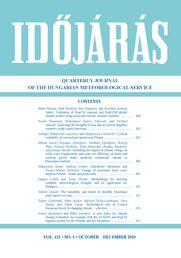IDŐJÁRÁS - angol nyelvű folyóirat
Vol. 123, No. 4 * Pages 409–576 * October - December 2019
 |
Special compilation: Environmental challenges – Smart solutions |
 letöltés [pdf: 3546 KB]
letöltés [pdf: 3546 KB]
Validation of RegCM regional and HadGEM global climate models using mean and extreme climatic variables
Ildikó Pieczka, Judit Bartholy, Rita Pongrácz, and Karolina Szabóné André
DOI:10.28974/idojaras.2019.4.1 (p. 409–)
Ildikó Pieczka, Judit Bartholy, Rita Pongrácz, and Karolina Szabóné André
DOI:10.28974/idojaras.2019.4.1 (p. 409–)
IDŐJÁRÁS folyóirat

Az IDŐJÁRÁS a HungaroMet Nonprofit Zrt. negyedévenként megjelenő angol nyelvű folyóirata
Megrendelhető a journal.idojaras@met.hu címen.
A szerzőknek szánt útmutató itt olvasható.
Megrendelhető a journal.idojaras@met.hu címen.
A szerzőknek szánt útmutató itt olvasható.









